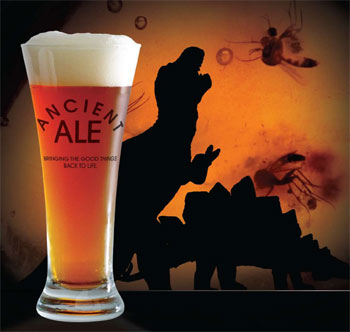Fossil Fuels Brewing Company of Manteca, California is convinced that beer, like wine, takes time to get right. In this case, 45 million years. It's truly a beer no one else can claim to have.
Manteca is a short drive from here so you can bet this story is just beginning. It's for science, after all.
Raul Cano, Cal Poly microbiologist and director of Cal Poly’s Environmental Biotechnology Institute (EBI) caused quite a brew-ha ha(1) with the announcement that beer made from living bacteria extracted from a bee entombed in amber 25-45 million years ago was really, really good.

With a motto like “Bringing Good Things Back to Life” this is one case where science going all Frankenstein on society can't have a bad ending. It's beer! It can never be too delicious.
Cano first published his discovery in Science in 1995(2) and, like all truly bold findings, was met with skepticism, but since then there have been three independent instances of the isolation of a living microorganism from amber so it seems more plausible now.
On their own, Cano and friends whipped up classics like T-Rex Lager, Stegosaurus Stout and Ancient Ale but they decided they needed a commercial brewer to get this out to the world.
For his part, Cano wants to put the money to scientific use. "Why waste good waste? I’m hoping to use profits from beer sales to fund biofuels research at Cal Poly’s EBI. The wastewater from beer production has a great deal of energy, therefore, potential to be reclaimed as biofuel,” Cano told Cal Poly Magazine.
Why is this ancient yeast so special? It's restricted to a narrow band of carbohydrates, according to Cano, which is unlike more modern yeasts that can consume just about any kind of sugar.
13 years of product planning plus 45 million years of development? They have definitely taken the time to get it right.
NOTES:
(1) That 'brew-haha' bit is far too clever to be original to me. Thank Pat Ketchum at Cal Poly Magazine.
(2) RJ Cano, MK Borucki, 'Revival and identification of bacterial spores in 25- to 40-million-year-old Dominican amber', Science 19 May 1995:Vol. 268. no. 5213, pp. 1060 - 1064 DOI: 10.1126/science.7538699




Comments